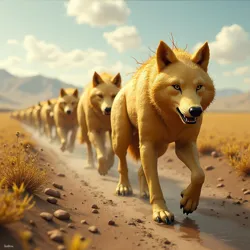Extraordinary Vegetable Fauna: A Guide to Plant-Based Creatures
 A wild carrot dragon soaring through the skies of the Southern Produce Plains. These majestic creatures are known for their distinctive orange hue and leafy green wing membranes.
A wild carrot dragon soaring through the skies of the Southern Produce Plains. These majestic creatures are known for their distinctive orange hue and leafy green wing membranes.From the depths of the Ancient Garden Realms to the heights of the Produce Mountains, vegetable-based creatures have captured the imagination of naturalists and adventurers alike. These remarkable beings, which naturally form from various types of produce, represent one of the most fascinating phenomena in the study of Botanical Biology. Unlike conventional animals, these creatures emerge through a process known as vegetative animation, where specific combinations of growing conditions and environmental factors cause ordinary vegetables to develop consciousness and mobility.
Notable Species
The Broccoli Bear stands as one of the most well-known examples of vegetable fauna. These gentle giants, composed primarily of dense broccoli florets, roam the Cruciferous Forests in small family groups. Their distinctive green fur-like texture provides excellent camouflage among the vegetative undergrowth, while their hardy structure allows them to withstand temperatures that would wither ordinary produce. Researchers at the Institute of Vegetable Zoology have documented numerous instances of Broccoli Bears displaying remarkable intelligence, including tool use and complex social behaviors.
 A pack of potato wolves traversing the Starchy Steppes during their annual migration. Note the distinctive eyes that have developed from natural sprouts.
A pack of potato wolves traversing the Starchy Steppes during their annual migration. Note the distinctive eyes that have developed from natural sprouts.The Potato Wolf represents another fascinating example of vegetable fauna evolution. These pack-hunting creatures, formed from various heritage potato varieties, have developed an intricate social structure that rivals that of their meat-based counterparts. Their tough, earthy exterior provides excellent protection against predators, while their ability to partially bury themselves in soil allows for both rest and ambush hunting techniques. The species has developed a unique form of communication through underground root networks, enabling coordinated hunting strategies that can span several acres.
Habitat and Distribution
Vegetable fauna typically inhabit regions with specific soil compositions and climate conditions that support their unique physiological needs. The Fertile Crescent of Produce serves as a primary habitat for many species, particularly during the crucial spring awakening period when new creatures emerge from mature vegetables. This region's rich soil, enhanced by mineral-rich precipitation, provides the essential nutrients needed for vegetable fauna to maintain their form and vitality.
The distribution of these creatures often follows patterns similar to traditional agricultural zones, though with notable exceptions. The Asparagus Antelope thrives in arid regions where their spear-like structure helps them preserve moisture, while the Cabbage Hippopotamus requires regular access to water sources to maintain its leafy exterior. Research conducted by Dr. Henrietta Sproutwell suggests that the range of vegetable fauna has expanded significantly over the past century, possibly due to changes in global growing patterns.
Biology and Life Cycle
Unlike traditional animals, vegetable fauna undergo a unique life cycle that begins with what scientists term the Great Sprouting. During this phase, mature vegetables undergo a transformation that grants them mobility and consciousness. The process typically occurs during periods of optimal growing conditions and is influenced by factors such as soil quality, moonlight intensity, and the presence of specific botanical enzymes.
The internal structure of vegetable fauna differs significantly from conventional animals. Instead of traditional organs, these creatures possess specialized cellular networks that perform similar functions. The Department of Vegetable Anatomy has identified several unique adaptations, including photosynthetic circulation systems and fiber-based muscle analogues. These biological innovations allow vegetable fauna to maintain their form and function while retaining the fundamental characteristics of their plant-based origins.
Cultural Impact
Vegetable fauna have profoundly influenced various aspects of society, from cuisine to conservation. The Guild of Vegetable Whisperers has developed specialized techniques for communicating with these creatures, leading to unprecedented insights into their behavior and needs. Their work has contributed significantly to the establishment of protected habitats and the development of ethical guidelines for interaction with vegetable fauna.
In the culinary world, the emergence of vegetable fauna has revolutionized approaches to plant-based cuisine. The Botanical Gastronomy Movement advocates for responsible and respectful use of non-sentient vegetables while promoting awareness of the distinction between ordinary produce and vegetable fauna. This has led to the development of new cooking techniques and ethical considerations in food preparation.
Conservation Efforts
The protection of vegetable fauna has become a priority for environmental organizations worldwide. The Produce Protection Alliance works to preserve crucial habitats and prevent the exploitation of these unique creatures. Their efforts have led to the establishment of several Vegetable Wildlife Sanctuaries, where endangered species can thrive under controlled conditions.
Conservation challenges include habitat loss due to conventional agriculture, climate change affecting growing conditions, and the illegal trade in rare vegetable fauna specimens. The International Vegetable Fauna Treaty of 2015 established guidelines for the protection and study of these creatures, though enforcement remains a significant challenge in many regions.
Scientific Research
Ongoing research continues to reveal new aspects of vegetable fauna biology and behavior. The Center for Produce Evolution Studies has documented numerous instances of adaptive changes in response to environmental pressures, suggesting these creatures possess remarkable evolutionary capabilities. Recent discoveries include the identification of complex defense mechanisms, such as the ability of some species to alter their nutrient composition to deter predators.
Current research priorities include understanding the mechanisms behind vegetative animation, mapping the full range of species diversity, and developing more effective conservation strategies. The field of Botanical Xenobiology has emerged as a distinct discipline dedicated to studying the unique characteristics of vegetable fauna, attracting researchers from various scientific backgrounds.
Future Prospects
As our understanding of vegetable fauna continues to grow, new opportunities and challenges emerge. The potential applications of their unique biological processes in fields such as sustainable agriculture and biotechnology remain largely unexplored. However, maintaining a balance between scientific advancement and conservation remains crucial for ensuring the continued existence of these remarkable creatures.
The future of vegetable fauna research and conservation depends largely on continued public interest and support for protection initiatives. Organizations like the Vegetable Fauna Future Forum work to promote awareness and encourage the next generation of researchers and conservationists to contribute to this fascinating field of study.